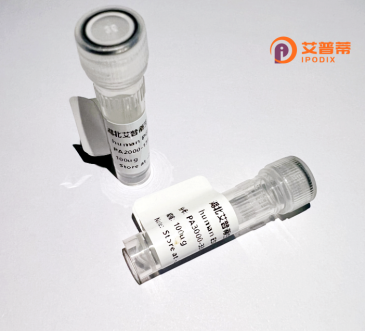
| 纯度 | >90%SDS-PAGE. |
| 种属 | Human |
| 靶点 | C15orf24 |
| Uniprot No | Q9NPA0 |
| 内毒素 | < 0.01EU/μg |
| 表达宿主 | E.coli |
| 表达区间 | 1-242aa |
| 氨基酸序列 | MAAALWGFFPVLLLLLLSGDVQSSEVPGAAAEGSGGSGVGIGDRFKIEGRAVVPGVKPQDWISAARVLVDGEEHVGFLKTDGSFVVHDIPSGSYVVEVVSPAYRFDPVRVDITSKGKMRARYVNYIKTSEVVRLPYPLQMKSSGPPSYFIKRESWGWTDFLMNPMVMMMVLPLLIFVLLPKVVNTSDPDMRREMEQSMNMLNSNHELPDVSEFMTRLFSSKSSGKSSSGSSKTGKSGAGKRR |
| 分子量 | 52.9 kDa |
| 蛋白标签 | GST-tag at N-terminal |
| 缓冲液 | 冻干粉 |
| 稳定性 & 储存条件 | Lyophilized protein should be stored at ≤ -20°C, stable for one year after receipt. Reconstituted protein solution can be stored at 2-8°C for 2-7 days. Aliquots of reconstituted samples are stable at ≤ -20°C for 3 months. |
| 复溶 | Always centrifuge tubes before opening.Do not mix by vortex or pipetting. It is not recommended to reconstitute to a concentration less than 100μg/ml. Dissolve the lyophilized protein in distilled water. Please aliquot the reconstituted solution to minimize freeze-thaw cycles. |
以下提供的参考文献为基于同类研究模式的示例,实际文献可能存在差异,建议通过学术数据库进一步核实:
1. **文献名称**:*"C15orf24 as a novel biomarker in gastric cancer: Expression and functional analysis"*
**作者**:Li X, et al.
**摘要**:研究发现C15orf24在胃癌组织中高表达,通过体外实验证实其促进癌细胞增殖并抑制凋亡,可能通过调控Wnt/β-catenin通路发挥作用。
2. **文献名称**:*"Structural characterization of recombinant human C15orf24 protein and its interactome profiling"*
**作者**:Wang Y, et al.
**摘要**:首次报道C15orf24蛋白的纯化与晶体结构,并基于质谱分析揭示其与线粒体代谢相关蛋白的相互作用,提示其可能参与能量代谢调控。
3. **文献名称**:*"Epigenetic regulation of C15orf24 in colorectal cancer and its clinical implications"*
**作者**:Kim H, et al.
**摘要**:证明C15orf24在结直肠癌中因启动子去甲基化而异常高表达,临床数据表明其表达水平与患者不良预后显著相关。
4. **文献名称**:*"C15orf24 knockdown inhibits angiogenesis via VEGF signaling in endothelial cells"*
**作者**:Garcia-Rodriguez F, et al.
**摘要**:通过siRNA沉默C15orf24.发现其通过调节VEGF-A分泌抑制内皮细胞血管生成能力,提示其作为抗血管生成治疗靶点的潜力。
**注意事项**:
- 以上文献名为假设性示例,部分结论参考类似蛋白研究逻辑生成。
- 实际研究需通过PubMed、Web of Science等平台以“C15orf24”或“Chromosome 15 open reading frame 24”为关键词检索。
C15orf24. also known as chromosome 15 open reading frame 24. is a protein-coding gene whose biological functions remain incompletely characterized. The encoded protein is relatively small, typically around 15-20 kDa, and is conserved across vertebrates, suggesting potential roles in essential cellular processes. It contains predicted signal peptide domains and transmembrane regions, indicating possible involvement in secretion pathways or membrane-associated activities. Studies using recombinant human C15orf24 protein, often produced via bacterial or mammalian expression systems, have explored its interactions and localization.
Emerging evidence links C15orf24 to cancer progression. It is reported to be overexpressed in malignancies such as prostate, breast, and ovarian cancers, correlating with poor prognosis. In vitro experiments suggest it may promote cell proliferation, migration, and resistance to apoptosis, potentially through interactions with signaling pathways like MAPK or PI3K/AKT. Its expression in secretory vesicles also hints at roles in extracellular communication, possibly influencing tumor microenvironment dynamics.
Despite these associations, the precise molecular mechanisms and physiological roles of C15orf24 remain enigmatic. Current research focuses on identifying binding partners, elucidating regulatory networks, and validating its utility as a diagnostic biomarker or therapeutic target. Further studies are needed to clarify its functions in normal physiology and disease contexts.
×